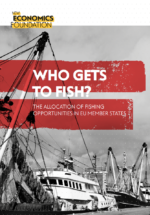Who Gets to Fish?
Fish stocks are owned by no one but desired by many. How, then, should access to fish stocks be determined?
15 March 2017
Fish stocks are owned by no one but desired by many. How, then, should access to fish stocks be determined? In the EU, member states have answered this question very differently, with many different systems in use. We analyse 12 countries in detail, and find that despite different systems designs, none of them are fully managing their fisheries in the public interest. In this report, we describe these systems of fishing opportunities, assess their performance against defined objectives, and make recommendations for reform.

Much has been written on the topic of overfishing and the large gains – environmental, economical, social – of managing fish stocks at larger population levels to support sustained catches. But far less is known, and facts are far harder to come by, on the similarly vexed issue of who gets given the right to fish. This report examines how 12 EU Member States make that decision – and the consequences that this can have. Whether it is the disappearance of fishing communities around the coast, the controversy over larger and larger factory trawlers, or the alarm over the privatisation of a public resource, many of the concerns about contemporary fisheries management are about how the resource is divided, not just the size.
To explore this issue of allocating fishing opportunities, we analyse 12 EU Member States in detail: Belgium, Denmark, France, Germany, Ireland, Italy, the Netherlands, Poland, Portugal, Spain, Sweden, and the UK. The systems of fishing opportunities in use vary significantly. Whilst fishers in Belgium and the Netherlands fish many of the same species in the same waters, the government-rationed quotas of the former, and market for ownership rights in the latter, are worlds apart in management approach. To assess whether a system of fishing opportunities is successful, we have developed a framework of 12 objectives (Table 1). Whilst not specifying a precise blueprint for fisheries, a successful system should achieve these objectives to allow fishers to thrive and the public to benefit, all whilst ensuring a good process of decision-making.
Download summary
Topics Fisheries & farming







